
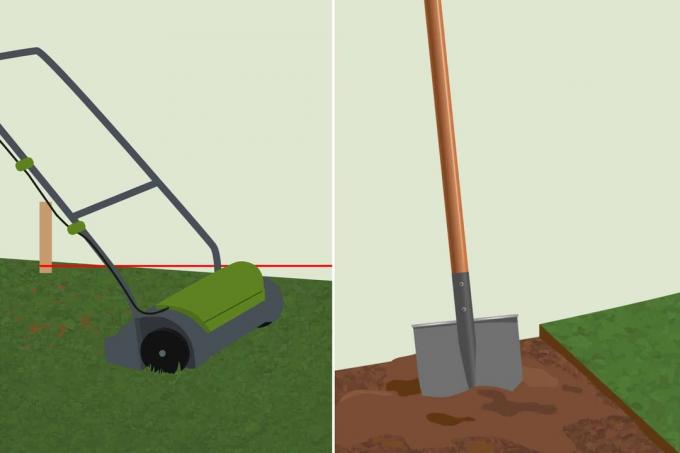
Table of contents
- Determine height difference: instructions
- time
- Compensate for unevenness in the lawn: 5 methods
- Fill up
- rolls
- clear lawn
- repair parts
- Plant ground cover
- frequently asked Questions
Unevenness in the lawn is annoying and poses a danger to gardeners, playing children and pets. There are a number of methods that can be used to level the lawn. We present them to you in our guide.
Determine height difference: instructions
Before you can even out bumps in the lawn, you need to know the actual height difference. This can be determined with little effort within a few minutes.
For this you need:
- 2 x wooden sticks
- 1 * String
- 1 * Bubble Level
- 1 * ruler
Ideally, you should use a roll of cord, such as cord, to have enough leeway when measuring. This is especially important for large lawns. The sticks should not be too short.
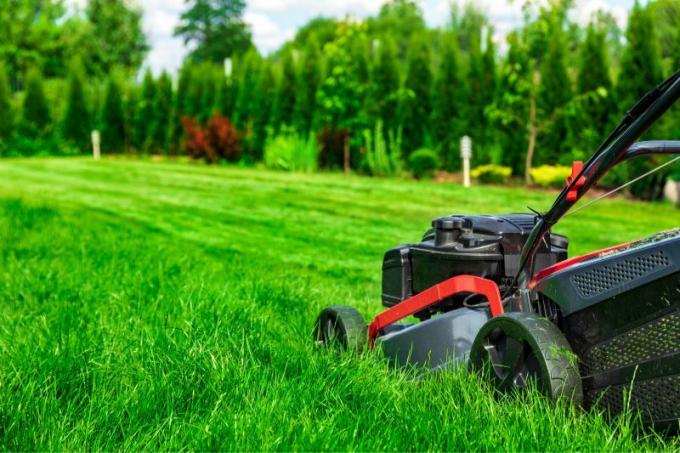
The height difference is then determined as follows:
- Find the highest and lowest points in the lawn. A sense of proportion is sufficient for this. Place a wooden stick at each of the selected locations. They serve as points for fixing the cord.
- Stretch a string between the woods. It must not sag, otherwise measurement errors may occur. The basis for determining the height difference is in place.
- Now push the string at the highest point to the lower end of the stick. Then push the end of the line at the lowest point up until the line is horizontal.
- If the line appears straight, use your spirit level for optimal alignment. Place the spirit level and adjust the string until it is exactly level. This will prevent measurement errors that could negatively impact the project.
- When the line is fully aligned, you can measure the difference in height to the ground using the guide line with a ruler. If you want to fill up the bumps completely, you can simply leave the cord where it is and align yourself with the height. This is particularly recommended for lawns with several depressions so that you do not have to determine them individually.
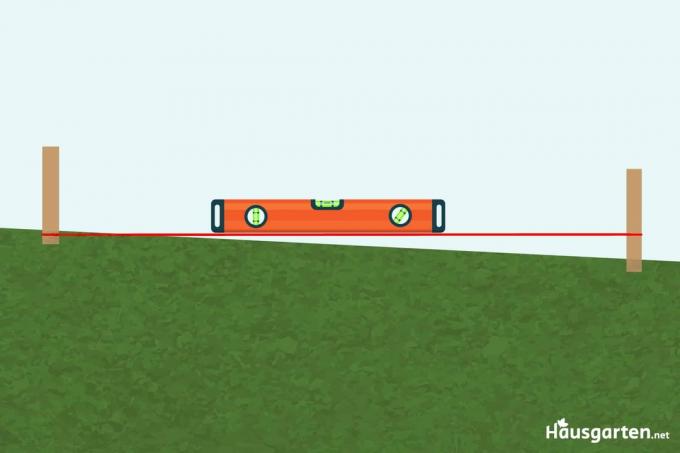
time
In addition to determining the difference in height, the appropriate time for the procedure must be observed when leveling the lawn. If the lawn is adjusted too late or too early in the year, damage can occur that has a negative effect on the vitality of the lawn. Since the lawn is a living area due to the grasses, you should not implement the project haphazardly. The period from mid-April to the end of May is particularly suitable for straightening the lawn. This is especially true for methods like filling in the bumps or removing individual hills, since you have to move a lot of soil. Since from April there is usually only little meltwater to be found after the winter, the amount of work is significantly reduced. Ideally, pick a day with the following climate:
- precipitation-free
- at least 10°C
- no danger of ground frost
A notice:
Small patches of lawn can also be repaired up to September as long as the intervention does not permanently damage the area.
Compensate for unevenness in the lawn: 5 methods
Fill up
One of the most popular ways to level out unevenness in the lawn is to fill it in. With this method, low depressions are filled with a topsoil-sand mixture. The biggest advantage: You don't need to seed again, as the lawn seeds easily break through the thin layer when germinating. Although you have to repeat the procedure throughout the season, as the ground always sinks slightly, you end up with a naturally level lawn.
You need:
- mixing bucket or wheelbarrow
- earth (topsoil)
- washed quartz sand (grain size 0 to 2 mm)
- shovel
The implementation is very simple:
- Mix sand and topsoil
- Mixing ratio 1:1
- Fill wells with mixture
- maximum layer thickness 1 cm
- water thoroughly
- leave for a period of 4 to 6 weeks
- repeat until autumn
rolls
Rolling is useful for small bumps where it is not worth using sand or earth to fill. For example, if the entire lawn is only slightly uneven, rolling is ideal. For this method you need a lawn roller that has a working weight of 80 to 100 kg. Depending on the model, these are filled with the following materials:
- sand
- Water
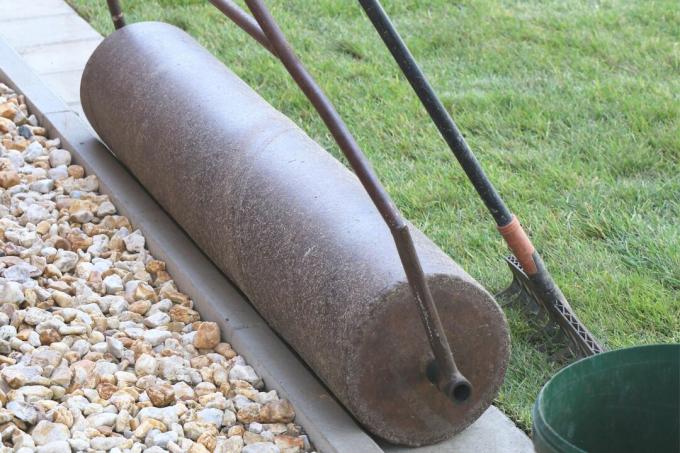
If you don't want to buy a lawn roller yourself because of the cost of 50 to 300 euros per piece, you can rent it from hardware stores or specialist dealers. You have to reckon with a fee of 10 to 20 euros per day. If the lawn roller is ready, proceed as follows:
- Mow the lawn before rolling
- water thoroughly when dry
- fill roller
- Push or pull the roller across the lawn
- lane by lane
- the lanes should overlap
- Avoid tight turns (protects against displacement)
- optimizes the result
- Lawn can be walked on again after 24 to 30 hours
A notice:
An alternative to the lawn roller is the vibrating plate, which is simply guided over the appropriate points. You can rent vibrating plates in DIY stores, from specialist dealers and online.
clear lawn
If filling in or rolling the surface is not enough to even out the unevenness, you will have to remove the lawn for better or worse. This is especially the case with lawns that are very hilly, which would lead to an extremely high amount of work with the methods already mentioned. Because of this, you need to clear the lawn to level it as effectively as possible.
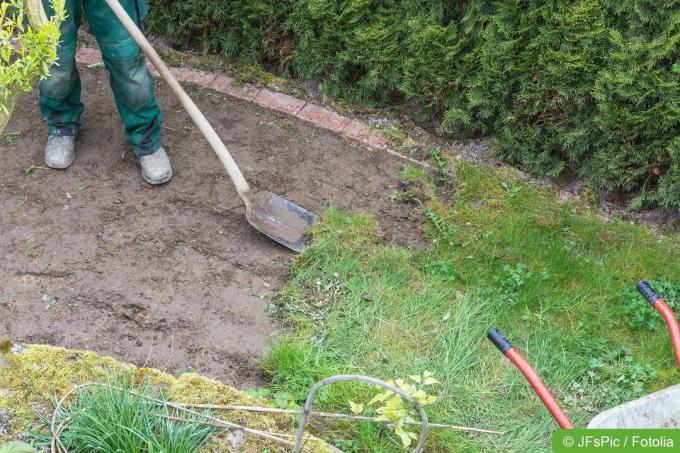
You will need the following supplies and materials for the project:
- mowing machine
- scarifier
- lawn roller
- shovel
- wheelbarrow
- earth (topsoil)
- washed quartz sand (grain size 0 to 2 mm)
- working gloves
- other weed removal tools such as weed pullers
- rake
- lawn fertilizer
- Lawn seed of your choice
The removal of the lawn is similar to a complete renewal:
- Start by mowing the lawn thoroughly and as short as possible. You do not have to dispose of the grass clippings as they are used as a natural fertiliser. Also remove weeds so that they can no longer spread after the new planting.
- Now you have to scarify the entire area. If the soil is too dry for this, just water it a little. As you scarify, level out small hills and larger bumps to even the height with the rest of the soil.
- After scarifying, fill in the dug area with a 1:1 sand/topsoil mixture if the desired height is not reached after clearing. Use the previously measured height difference or the guideline that you have not yet removed as a guide. You can use the rake to evenly subtract the area.
- Wait five to seven days. The soil will now have settled somewhat, making it easy to fill in more soil where necessary. Repeat this step again if necessary.
- Finally, roll the surface, provide lawn fertilizer and lawn seed. Water thoroughly and care as usual.

repair parts
If there are small areas in the lawn that need to be leveled, you can save yourself a lot of work. This is possible by removing the turf at the respective location, adjusting the ground and then repositioning the lawn correctly. The section establishes itself over the next few weeks and ensures a well-closed lawn area without the risk of tripping. In addition to the utensils mentioned above, you will need a lawn edger for this method. It enables the lawn to be cut cleanly and easily in order to remove the sections without damaging them. The tool is already available for 20 to 30 euros.
The following guide will walk you through each step of the method:
- Cut out the desired area with the lawn edger. To do this, use a cross shape to divide the piece into four parts. Don't forget to prick the edge of the piece as well.
- Now fold the individual pieces inside out to remove them. This makes it possible to easily remove them and re-establish them later. You can theoretically just leave it there after opening it and fold it down again at the end.
- Thoroughly loosen the soil under the lawn with a spade to loosen any compaction. Furthermore, this makes it easier for the sections to grow, since the soil is much more permeable to air and structured.
- You can then fill or remove the area as needed. To do this, follow the instructions described so far. Tread the earth thoroughly so that the sections can lie exactly.
- Then simply place the sections back on the ground. If there are still bumps, repeat the process. The lawn can then be maintained as usual.

A notice:
Use caution tape to mark the repaired spot in the lawn. This prevents the lawn from becoming uneven again due to excessive loading.
Plant ground cover
Planting ground cover is another way to level out unevenness in the lawn. This is only recommended for small spots or if the uneven surface is on the edges or in the corners. Ground covers grow low and form dense cushions that are ideal for adapting to small differences in height. Depending on the species you choose, you must adapt the soil to the plant's requirements at the desired location and fill it up with substrate. The ground cover then works as a lawn replacement and even sets decorative accents.

Recommended ground cover for uneven lawns are:
- feather pad (Cotula squalida)
- Pennywort (Lysimachia nummularia)
- Pennyroyal (Mentha pulegium)
- Roman chamomile (Chamaemelum nobile)
- Wild thyme (Thymus serpyllum)
- Hot Stonecrop (Sedum acre)
- Star Moss (Sagina subulata)
frequently asked Questions
The most common cause is waterlogging, which is caused by compacted soil or missing or inadequate drainage. This is followed by depressions that lead to bumps. Furthermore, animals such as moles and voles can visibly dig up the lawn. Other reasons are too heavy a load on moist soil, tree and bush roots, as well as mistakes when laying out the lawn.
After leveling out the unevenness, the lawn should be watered extensively. This prevents the soil from drying out immediately, which in turn would lead to compaction. Depending on the method, new seed must also be sown and fertilizer incorporated.
 Maike
Maike
Learn more about lawn care

Leveling the lawn: how to smooth uneven surfaces
Dents and holes in the lawn are unsightly. We will show you step by step how to smooth uneven areas in the lawn again.

Algae in the garden | Lawn is slippery: what to do?
Algae love rainy days. Can the water seep badly into the ground, even better! The green, slippery mass is not only not a pretty sight, but also a danger for the lawn. Only those who act preventively and correctly in acute cases can avoid permanent damage.

Fighting fungi in the lawn | 10 tips against fungal infestation
Mushrooms in the lawn are not uncommon but annoying and sometimes even dangerous. This is especially true if the garden or green space is also used by pets and children. Here we will show you how to combat fungal infestation.

Aerate the lawn | Before or after mowing?
Sun, water, fertilizer and air are necessary for the lawn to grow. If the lawn does not get enough air, it cannot grow properly. We clarify when the right time to ventilate the lawn is.

Mulching with lawn clippings: 13 things to consider
Keeping the lawn short is a must for many hobby gardeners. However, if the lawn mower does not have a mulching function so that the grass clippings can remain on the lawn, the question arises as to where to put the waste. Because the compost heap is not a good solution here.
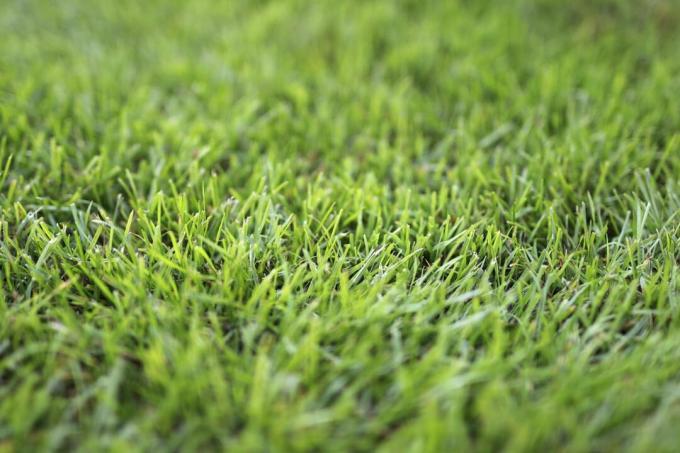
How much soil do I need per m²: Apply lawn soil
If an area in the garden is to be converted into a lawn, then it makes sense to distribute the appropriate soil as a substrate. This raises the question of how much lawn substrate is required per m² of area. It does not matter whether turf or sowing is used afterwards.



